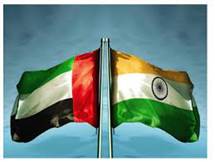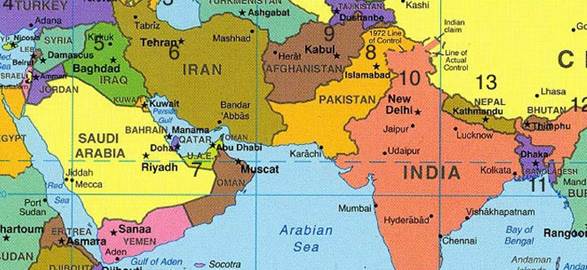Description

Copyright infringement not intended
Context:
- The Union Cabinet has approved the proposal for signing a bilateral Memorandum of Understanding (MoU) between India and the United Arab Emirates (UAE) on Cooperation in the field of Industries and Advanced Technologies.
More on the news:
- Growing India-UAE economic and commercial relations contribute to the stability and strength of a rapid diversifying and deepening bilateral relationship between the two countries.
- India-UAE bilateral trade, valued at US$ 180 million per annum in the 1970s has increased to US$ 60 billion making the UAE, India's third-largest trading partner for the year 2019-20 after China and the US.
- Moreover, the UAE is the second-largest export destination of India (after US) with an export value of US$ 29 billion for the year 2019-2020.
- The UAE is the eighth largest investor in India with an estimated investment of US$ 18 billion.
- India and the UAE signed a bilateral "Comprehensive Economic Partnership Agreement" (CEPA) in February.
- The MoU envisages cooperation on a mutually beneficial basis in the following areas:
- Strengthening the Supply Chain Resilience of Industries
- Renewable & Energy Efficiency
- Health and life sciences
- Space Systems
- Artificial Intelligence
- Industry 4.0 Enabling Technologies
- Standardization, metrology, conformity assessment, accreditation, and Halal certification.

Copyright infringement not intended
Background:
- Political:
- India and the United Arab Emirates (UAE) established diplomatic relations in 1972.
- The traditionally strong bilateral relations enjoyed by India & UAE received impetus with the visit of PM Modi to UAE in 2015 that marked the beginning of a new strategic partnership.
- Sheikh Mohamed bin Zayed Al Nahyan, (MBZ) Crown Prince of Abu Dhabi visited India again in as the Chief Guest at India’s Republic day celebrations.
- It was during this visit that the bilateral relations were upgraded to a ‘Comprehensive Strategic Partnership’.
- PM Modi visited UAE again in 2018 for the World Government Summit in Dubai, where India was the Guest of Honor.
- PM received the UAE's highest civilian award, 'the Order of Zayed’ in 2019.
- The visit also witnessed the official launch of the ‘RuPay Card’ in UAE, and the release of a set of stamps issued by Emirates Post commemorating the 150th Birth Anniversary of Gandhi.
- Economic & Commercial Relations:
- India and UAE have shared trade links through the centuries.
- Trade, which was dominated by traditional items such as dates, pearl and fishes, underwent a sharp change after the discovery of oil in UAE.
- The real impetus, however, started after Dubai positioned itself as a regional trading hub by the early 1990s and about the same time, the economic liberalization process started in India.
- India-UAE trade is today around US$ 60 billion, making UAE, India's third largest trading partner for the year 2018-19.
- Moreover, UAE is the second largest export destination of India (after US) with an amount of over US$ 30 billion for the year 2018-19.
- For UAE, India was the second largest trading partner during 2018.
- UAE is the 10th biggest FDI investor for India.
- A consortium led by ONGC was awarded a 10 per cent stake in the Lower Zakum Concession in 2018.- first time that the Emirate awarded a stake in a functioning oil field to an Indian group.
- NRI Remittances: The annual remittances made by the large Indian community in UAE amount to over US$ 17.56 billion (2018).
- Cultural Relations:
- Indian expatriate community of approx. 3 millions is the largest ethnic community in UAE constituting roughly about 30 per cent of the country’s population.
- Among the Indian States, Kerala is the most represented followed by Tamil Nadu and Andhra Pradesh.
- Today, around 35% of the Indian community is made up of professionally qualified personnel, businessmen & other white collar non-professionals.
- The Indian community has played a major role in the economic development of the UAE and is respected for its technical competence, sense of discipline & law abiding nature.
- Indian schools: There are 130 Indian schools in the UAE following the CBSE and Kerala Board curricula with approx 219,000 students.
- Defence and Security Cooperation:
- There have been regular high level & functional level exchanges between the two countries.
- The ships of the Navies of both countries have regularly made port calls enhancing bilateral defence co-operation.
- UAE Air Force Officers participated as Observers in Trilateral Air Exercise on Humanitarian Assistance & Disaster Relief (HADR) in 2018.
- Indian Navy Ships participated in the maiden IN-UAEN Bilateral Exercise in 2018 named Gulf Star 1.
- IN Ships have been regularly participating in IDEX/NAVDEX held in Abu Dhabi biennially.
- ‘Desert Eagle II’, a ten-day air combat exercise, was held in 2016 between the air forces of India and UAE.
- That New Delhi could turn to the UAE for help to deploy its mid-air refuellers for Rafale jets, and it agreed to extend the facility, is seen to reflect the close relationship that India and Abu Dhabi have built
- While India and UAE are constantly in touch with each other through institutionalised deradicalisation programmes and promote tolerance, Abu Dhabi has turned into a no-go area for anyone looking for a haven after fleeing Indian law enforcement agencies.
- Not only has UAE deported more than 100 Indian fugitives back, but it also helped India with real-time intelligence from Iraq and Syria during the rise of the so-called Islamic State.
- The UAE also helped India keep a watch on the Indian diaspora from getting sucked into the ultra-conservative Sunni movement and stopped them from joining Islamic State jihad.
Why the relations are on a upswing?
- Diversification of UAE economy: Foreign trade and the oil and gas sectors were the fulcrum of bilateral relations in the decades preceding the end of the oil era boom. But since then, the UAE has pursued an aggressive strategy of diversifying its economy, and its relations with India have benefited as a result.
- Evolving country profile and priorities: The recent upsurge in relations is a reminder that both the UAE and India have leapfrogged in terms of global reputation and foreign policy since 1981.
- Key partners in combating extremism: The UAE and India share a deeply common goal — fighting terrorism, combating extremism and ideologies of hatred.
- The two countries have a common interest in ensuing maritime security in the Indian Ocean and the Gulf region.
- Common economic goals: India has now become the world’s one of the fastest growing major economy and the third largest consumer of oil. On the other hand, the UAE has sovereign funds with a corpus of over a trillion dollars.
- Rigorous follow up to strategic partnership: Another reason for the greater depth in relations is the rigorous structure of various committees that have been set up following the high-level visits.
- Greater mobility of people: With a 3.3-million-strong population, the Indian diaspora in the UAE is the largest in the world, and growing. And with a record 1,076 flights every week between the UAE and India, there has also been a surge of tourists and visitors between the two countries.
- Energy Security: UAE is the 5th largest import source and accounts for about 6% of India’s total crude imports
- Investment: The UAE government has committed USD 75 billion towards developing Indian infrastructure.
- Further, given the current state of flux in West Asia, India sees the UAE as an important partner to maintain peace and stability in the region.
Challenges:
- As far as investments are concerned, the systemic problem faced due to slow implementation of various projects from Indian side is a major obstacle.
- Indian companies operating in the UAE also face problems due to lack of clarity in many aspects of commercial regulations, labor laws and lack of transparency on part of Emirati businesses.
- There is also a need to smoothen problems faced by Indian migrants due to cumbersome and strict regulations that favour the Emirati employers and at times leads to serious problems for Indian workers, especially unskilled workers.
Analysis:
- Since 2014, Indian foreign policy has witnessed significant changes in approach, priority issues, and focus.
- The relationship with United Arab Emirates (UAE) is at the core of an assertive new Gulf policy subsumed under the “Extended Neighborhood Policy.”
- Mutually reinforcing economic visions and compatible geopolitical outlooks have laid the basis for a more robust and promising partnership between India and the UAE.
- The Emirates’ plans to develop a diversified, knowledge-based 21st century economy have dovetailed with the Modi administration’s blueprint for unleashing India’s economic potential.
- Both sides recognize that the security of the Gulf and the Indian Ocean are indivisible. They also appreciate the threat posed by non-state violent extremists to their respective interests.
- The UAE is regarded not only as a major trade partner but also as a valuable source of foreign direct investment (FDI) in India’s drive to develop a $5 trillion dollar economy.
- India — the world’s fastest expanding market opportunity, with its talent pool of human capital, well acknowledged for innovation and UAE — a hub of cutting-age technologies — are natural partners in the field of Artificial Intelligence.
- Space is a new arena in which India and the UAE have collaborated through the work of the UAE Space Agency and ISRO. Together, the two space agencies have developed the nano-satellite, Nayif-1 and are likely to work together on Emirates’ ‘Red planet Mission’.
Way Forward:
- The growing engagements between India and the UAE has to be seen within the broader contexts of UAE’s policy of engaging with Asia to improve economic prospects and India’s search for foreign investments to expedite economic growth and address the threat of extremism and terrorism.
- Medical tourism can be an important area where India can attract UAE given India’s high quality man power in medical sector and improving medical infrastructure in the country.
- There are further untapped potentials in the arena of renewable energy. The cost for production and transmission of solar energy in the UAE are a fraction to that of India and this is a priority area for the UAE government.
https://www.pib.gov.in/PressReleasePage.aspx?PRID=1832176
1.png)













